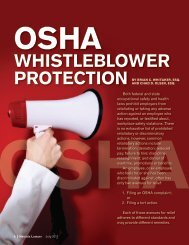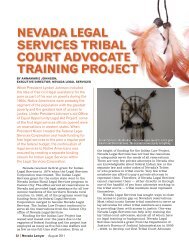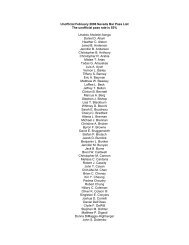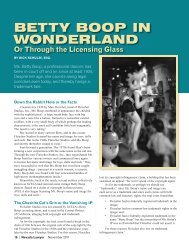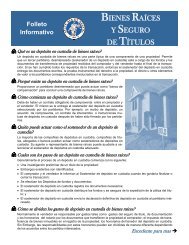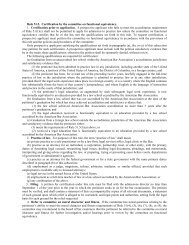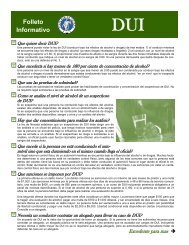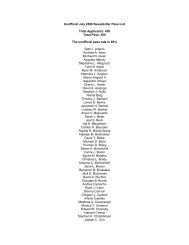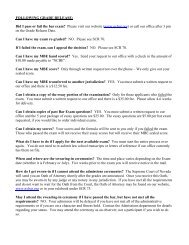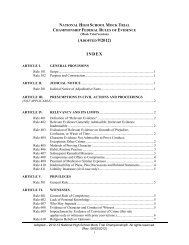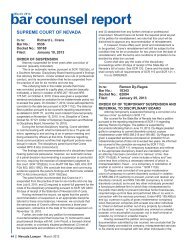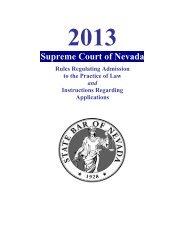ACTION - State Bar Of Nevada
ACTION - State Bar Of Nevada
ACTION - State Bar Of Nevada
You also want an ePaper? Increase the reach of your titles
YUMPU automatically turns print PDFs into web optimized ePapers that Google loves.
N E V A D A L A W Y E R A P R I L 2 0 0 9<br />
FORECLOSURE<br />
IN NEVADA<br />
ONE-<br />
<strong>ACTION</strong><br />
RULE<br />
BY MATTHEW WATSON, ESQ.<br />
With the recent downturn in the national<br />
economy and tightening of credit markets,<br />
questions from lenders to real estate lawyers<br />
have changed from something like “can you<br />
help us to document a construction loan?”<br />
to “how do we foreclose on a deed of trust<br />
in <strong>Nevada</strong>?” 1 This unfortunate reality has<br />
prompted many lawyers who previously<br />
focused on real estate lending, or who may not<br />
do much real estate work at all, to learn about<br />
workouts and foreclosures.<br />
One of the first things foreclosing lenders often ask<br />
is whether <strong>Nevada</strong> has a one-action rule. Many lenders<br />
are familiar with one-action rules from other states,<br />
but will need the <strong>Nevada</strong> rule explained. <strong>Nevada</strong>’s<br />
one-action rule, set forth in NRS 40.430, says that<br />
“there may be but one action for the recovery of any<br />
debt, or for the enforcement of any right secured by a<br />
mortgage or other lien upon real estate. That action must<br />
be in accordance with the provisions of NRS 40.430 to<br />
40.459, inclusive.” 2 In other words, the lender generally<br />
must complete the foreclosure process, or “exhaust the<br />
security before recovering from the debtor personally,”<br />
before pursuing the borrower for the payment of the<br />
debt. Bonicamp v. Vazquez. 3<br />
Violating the rule by bringing an action against<br />
the borrower before completing a foreclosure vests<br />
in the borrower an affirmative defense against the<br />
action. 4 Raising the affirmative defense will result, on<br />
a motion by any party, in the dismissal of the action<br />
without prejudice or the granting of a continuance and<br />
order by the court to amend the pleadings such that the<br />
action does not violate the one-action rule. 5 Should the<br />
borrower not raise the defense, and the action proceed<br />
to a final judgment, the entry of the final judgment will<br />
discharge the lien encumbering the real property. 6 Once<br />
the real property security is lost, the lender can no longer<br />
foreclose and is left only with a judgment against the<br />
borrower. The borrower can therefore use the one-action<br />
rule as a shield or a sword, with potentially devastating<br />
results for a lender. 7<br />
CONTINUED ON PAGE 12<br />
11
12<br />
A P R I L 2 0 0 9 N E V A D A L A W Y E R<br />
ONE <strong>ACTION</strong> RULE CONTINUED FROM PAGE 11<br />
Most guarantors of real estate-secured loans can,<br />
and often do, waive the benefits of the one-action<br />
rule. 8 Guarantors that are not permitted to waive the<br />
one-action rule are guarantors of loans for which the<br />
principal balance never exceeds $500,000, a loan from the<br />
seller of real property secured by the real property that is<br />
sold, loans secured by real property that is primarily used<br />
for the production of farm products, and loans secured<br />
by real property upon which the owner maintains his<br />
principal residence with not more than one residential<br />
structure and on which not more than four families<br />
reside. 9 If a guarantor has properly waived the one-action<br />
rule, then the lender may bring a separate action against<br />
that guarantor before completing a foreclosure without<br />
violating the rule. In practice, this would allow a lender<br />
to sue the guarantor either before or concurrently with a<br />
foreclosure proceeding.<br />
There are several exceptions to what constitutes an<br />
“action.” 10 They include the appointment of a receiver,<br />
enforcing a security interest in an assignment of rents,<br />
exercising a power of sale (a nonjudicial foreclosure), and<br />
a useful catch-all of anything “which does not include the<br />
collection of the debt or realization of the collateral securing<br />
the debt.” 11 Though the list does not purport to be exclusive,<br />
and the statute does not define the term “action,” the court<br />
in Bonicamp cited the long list of exceptions in the statute,<br />
noted that the actions brought in that case were not in the<br />
list, and held that they were actions for the purposes of NRS<br />
40.430. The safer view is that anything not specifically listed<br />
in NRS 40.430(4) as not constituting an action is an action<br />
and should be avoided. This includes, as it did in Bonicamp,<br />
an action brought in another state. Bringing any type of<br />
action against a borrower or guarantor before completing a<br />
foreclosure should be carefully considered given the potential<br />
harm should the lender not properly follow the statute.<br />
Once the foreclosure is complete and the real property is<br />
sold at a trustee’s sale, the lender may bring an action for a<br />
deficiency judgment, which will result in a personal judgment<br />
against the borrower in the amount of the deficiency. 12 That<br />
action must be brought within six months after the date<br />
of the foreclosure sale, or if there is more than one parcel<br />
of property, more than one interest in the real property or<br />
more than one deed of trust, within six months after the date<br />
of foreclosure sale of the last parcel, but in any event not
A P R I L 2 0 0 9<br />
later than two years after the initial<br />
foreclosure sale. 13 The deficiency<br />
judgment is the lesser of :<br />
(i) the amount by which the debt<br />
exceeds the fair market value of<br />
the real property as of the date of<br />
the sale; and<br />
(ii) the amount by which the debt<br />
exceeds the amount for which<br />
the real property was sold at the<br />
sale, in each case with interest<br />
from the date of sale.<br />
The one-action rule has many<br />
traps for the unwary. Be careful<br />
when foreclosing on a loan secured<br />
by real property, and think twice or<br />
even three times before bringing any<br />
sort of action against the borrower,<br />
guarantor or any other party to<br />
any of the loan documents before<br />
completing a foreclosure.<br />
MATTHEW WATSON is a<br />
shareholder with Lionel Sawyer &<br />
Collins in Las Vegas. His practice<br />
focuses on leasing, real estate<br />
development and finance, including<br />
foreclosures and workouts. He is a<br />
member of the executive committee<br />
of the Real Estate Section of the <strong>State</strong><br />
<strong>Bar</strong> of <strong>Nevada</strong> and chairman of the<br />
commercial leasing subcommittee.<br />
1 This article presumes that the lender’s<br />
security interest is created by a deed of<br />
trust rather than a mortgage.<br />
2 NRS 40.430(1).<br />
3 Bonicamp v. Vazquez, 120 Nev. 377,<br />
91 P.3d 584, 586 (2004). Not all<br />
defaults, however, will permit a lender<br />
to foreclose. See Manke v. Prautsch,<br />
81 Nev. 261, 401 P.2d 680 (1965)<br />
(foreclosure not permitted when default<br />
did not impair the security for the debt).<br />
4 NRS 40.435(2).<br />
5 Id.<br />
6 NRS 40.435(3).<br />
7 See, e.g., Bonicamp 91 P.3d at 586.<br />
8 NRS 40.495(2).<br />
9 NRS 40.430(4).<br />
10 NRS 40.430(4).<br />
11 NRS 40.430(a), (b), (e) & (m).<br />
12 NRS 40.455.<br />
13 NRS 40.455(2).<br />
13



